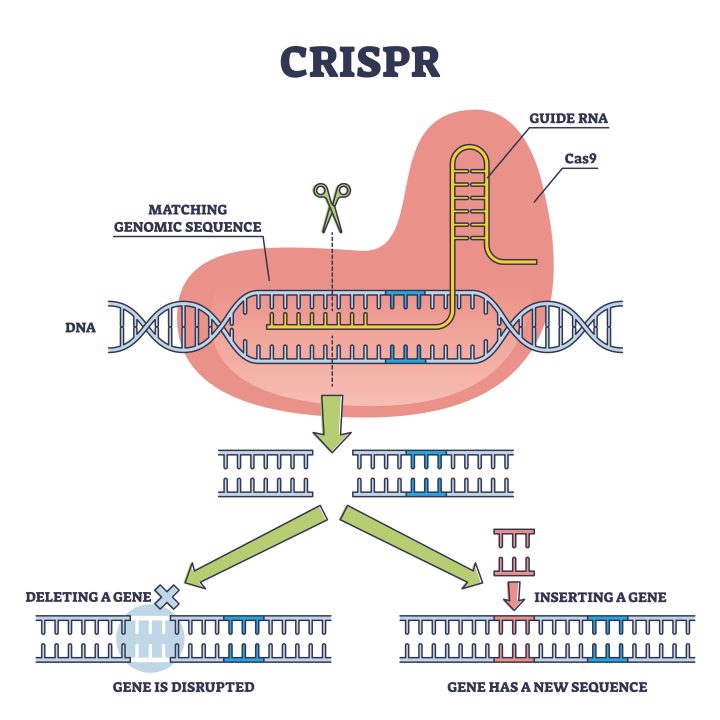What is CRISPR Technology?
CRISPR allows scientists to make precise changes in DNA, the hereditary information found in all living organisms. Scientists use this technology to develop new medicines, tests to quickly identify diseases like COVID-19, and to strengthen crops.
To edit genomes, researchers program Cas9 with a guide RNA and add it to cells they want to target. The enzyme will search the genome for matching DNA sequences and bind to them. It then cuts the DNA, creating a double-strand break (DSB).
What is the CRISPR system used for?
CRISPR is a revolutionary gene-editing technology that has taken science by storm. It is based on a natural adaptation found in the DNA of bacteria and other single-celled organisms.
Scientists have exploited this adaptation to create a tool that allows them to precisely modify the DNA of plants, animals, and humans. The tool uses a protein called Cas9, which acts like a pair of molecular scissors that can cut both strands of DNA. It is guided to a specific target by a short section of RNA.
The RNA section is designed to match the target DNA sequence. It is then bound by a protein that helps guide the Cas9 nuclease to the correct site. Once there, the Cas9 enzyme can cut the target DNA at its corresponding “spacer” sequence.
The spacer sequences contain bits of viral genetic code that have been captured by a bacterium during a previous infection. By using this memory, the bacterium can recognize and destroy viruses that have invaded it again. Think of these sequences as a “Wanted” poster for viruses.
What is the use of CRISPR in humans?
The CRISPR-Cas9 system is a tool for editing DNA in cells. It allows scientists to cut out or add new genes, and it can be used to treat certain diseases. For example, it has been used in a clinical trial to treat Leber’s Congenital Amaurosis, a genetic disease that causes vision loss and blindness.
Researchers have also used CRISPR to create genetically modified animals and plants. They have used it to make disease-resistant crops, and they have even used it to bring back extinct species such as the passenger pigeon.
The CRISPR-Cas9 technology is an incredibly powerful tool for scientific research. It can be used to edit the genomes of cells and organisms, which can help researchers better understand how genes work. It can also be used to create customized drugs that target specific diseases. For example, researchers have used CRISPR to correct the genetic mutation that causes hemophilia, a bleeding disorder that prevents the body from making enough blood-clotting proteins. They did this by taking cells from the patient’s bone marrow and then using CRISPR to edit them before returning them to the patient.
Is CRISPR a biotechnology?
Using CRISPR, scientists can make specific changes in the DNA of cells from fruit flies, fish, plants, mice and people. They can remove genes that cause disease, alter the way a gene functions or add new ones. These techniques give scientists powerful new tools to study fundamental questions in biology, improve agriculture and treat disease.
The bacterial CRISPR system is composed of repeating sequences of genetic code interrupted by “spacer” sequences that contain pieces of DNA from invading viruses. In 2012, American scientist Jennifer Doudna and French scientist Emmanuelle Charpentier discovered that CRISPR’s Cas enzyme could be reprogrammed to cut DNA in a desired sequence by providing it with guide RNA molecules made in a lab. The work earned them the 2020 Nobel Prize in Chemistry.
Since then, researchers have adapted the CRISPR system to edit the genomes of other organisms, including humans. Several ongoing human studies are using the technique to correct mutations in the DNA that cause disease. Unlike previous genetic engineering methods, CRISPR makes it easier to precisely target cells in the body. However, there are still challenges to overcome before the technology can be used in clinical applications such as curing blindness or cancer.
What is an example of a CRISPR technology?
CRISPR is a powerful new tool that lets scientists make targeted changes to DNA. Scientists can use this technology to treat diseases, develop stronger crops, and study fundamental biology. However, there are concerns that the technology could be misused or lead to unintended consequences.
The CRISPR system is a natural defense mechanism in bacteria and archaea, a group of relatively simple single-celled microorganisms. These organisms use RNA, a molecular cousin to DNA, and Cas proteins to foil attacks by viruses. When a virus invades, the organisms chop up some of the viral DNA and stow away bits of it in their genome. This allows them to recognize the invaders if they attack again.
Scientists can now engineer CRISPR components into more complex organisms, like humans. In 2019, a team of researchers used the technology to modify immune cells that can better “see” and kill cancer cells. They also edited genes that code for protein components involved in the heart, including a gene that helps regulate cholesterol levels. This allowed them to reduce the amount of low-density lipoprotein (LDLC) cholesterol in the bloodstream.
Is CRISPR biology or chemistry?
CRISPR is a gene-editing technology that was developed based on a natural adaptation found in bacteria and other single-celled organisms. The technology is able to precisely modify genes inside cells and has already revolutionized science by making it possible to do everything from resurrect extinct species to developing cures for deadly diseases.
The system works by using DNA sequences taken from invading viruses. This DNA is stored in a region of the genome called CRISPR, which stands for clustered regularly interspersed short palindromic repeats. Each segment of the DNA is bookended by “spacers,” which are similar to parts of the virus’s genetic code. When a virus invades the cell, the spacers help the enzyme Cas find and slice up the viral DNA.
The spacers then incorporate the viral DNA into the bacterial genome. This creates a kind of molecular memory that allows the bacteria to recognize and destroy the same virus in future attacks. The process also allows the bacteria to add new spacers to their CRISPR region, which builds up immunity to different types of viruses.
Is CRISPR a bioinformatics?
CRISPR is a revolutionary gene-editing technology that’s causing a major upheaval in science. It allows scientists to edit genes in cells and organisms quickly, cheaply, and easily. It’s been used to do everything from resurrect extinct species to develop cures for chronic disease. But it’s also sparked ethical debates, including over the possibility of creating “gene-edited babies.”
The technology is based on a system found in prokaryotic bacteria to fight viruses. The system uses short palindromic repeats of DNA bookended by “spacers.” Bacteria swipe spacers from attacking viruses and incorporate them into their own genomes. This acts as a kind of memory, enabling the bacteria to recognize and stop viruses from attacking again.
In 2012, French microbiologist Emmanuelle Charpentier and American biochemist Jennifer Doudna discovered that Cas enzymes can be programmed to cut nearly any target sequence of DNA in a cell. To do so, they pair the Cas9 protein with RNA sequences that tell it where to cut. These RNAs are known as guide RNA. Customizable Cas proteins can also be designed to turn genes on and off, a process called gene editing.
Is CRISPR a medical technology?
There are more than 7,000 monogenetic diseases, which means they are caused by a single gene that is defective. CRISPR makes it much easier to study these diseases. Researchers can identify potential disease-causing DNA sequences by analyzing patients’ genomes, then insert them into cells in the lab and test whether those cells develop characteristics associated with the disease.
It’s also a powerful tool for studying multi-gene diseases, which are caused by combinations of genes. For example, back problems may be partly due to a gene that makes people more prone to injury or a gene that causes a person’s immune system to not work properly. However, environmental and lifestyle factors can also play a big role in how these genes affect health.
The CRISPR system uses a DNA-cutting enzyme, called Cas9. It recognizes specific sequences of DNA and cuts them. It’s similar to how our own bodies cut and destroy viruses that enter our cells. CRISPR is simpler, cheaper, and more precise than previous gene-editing tools. It has already been used to treat genetic diseases, like sickle cell disease, in human clinical trials. It’s also being used to engineer mosquitoes to help fight malaria, and grow drought-resistant crops.
Is CRISPR basic or applied science?
CRISPR is a revolutionary gene-editing tool that has changed how scientists study diseases, treat patients, and improve the quality of crops. But the technology also raises ethical concerns about its potential to alter our species’ future.
The basic CRISPR-Cas9 system consists of specialized sequences of DNA interrupted by “spacer” sequences containing genetic code from invading viruses. Scientists figured out how to adapt the bacterial system to cut DNA at specific sites in cells, a technique that can be used to modify or delete genes.
To use CRISPR to edit a gene, researchers deliver Cas9 proteins and a pool of different guide RNAs (gRNA) into a batch of cells. Each gRNA matches a specific section of the genome and directs Cas9 to cut that portion of the DNA. Then, the researchers grow the cells under conditions that allow only those with a desired trait to survive.
The remaining cells can then be sequenced to identify the targeted gene or genes. This method allows scientists to quickly and accurately see how changes in a gene affect a particular trait.



